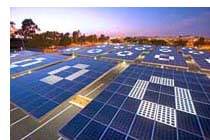Envision a solar parking lot: cool, clean and green


The picture above shows the roof, or the overaching top of the solar grove. Picture courtesy of Kyocera and Envision. In a separate blog I have all the specs of that project for the engineers who are interested. If you were a poli sci major you may not want to click through.
One of Noble's points is that he sees solar from an architect's viewpoint. It can be both functional and beautiful. It can be part of the overall design and pay economic dividens to the building owner. And, he says, more and more corporations are coming to realize it is not their lobby that gives a first impression to visitors, it's the parking lot they must contend with first. One of Noble's associates says any company's image begins at the curb, not at the lobby door. A solar, shaded parking lot is a very different message than forty acres of asphalt under the noonday sun. A pretty point, I must admit.
NREL Project
Noble's company is now at work installing one of their solar trees at the federal National Renewable Energy Lab in Colorado. The solar tree has a single trunk and a canopy supporting solar receptors that produce electricity. NREL wants the tree to use with two plug-in hybrid cars they'll be testing. Coincidentally the tree can accommodate both vehicles at once. These plug-in hybrids will recharge their electrical batteries from a 120 volt socket, not simply depending on the engine of the car for re-charging. This will presumably enable future hyrbid cars to use more electrical power, less fossil or bio-fuel.
After ther NREL Nsolar tree begins producing electricity later this year, the NREL researchers will use it in their testing of two plug-in hybrids: a Toyota Prius and a Ford.
Made in the Shade
There are millions of acres of paved parking in America. Most of it has no shade. Noble sees shade as a valuable resource in the future. He says some parking companies already charge more for spaces that are shaded. And currently the space above most parking lots is wasted. The lot itself is a tremendous heat island in summer, creating hotter weather for the people and buildings around it. You heard of global warming, think insular warming. Solar trees "planted" into solar groves could cover all those parking lots. That would not only provide shade but produce valuable electricity for the parking lot owner. If electric cars become more and more common, the synergy between parking space and electricity produced on location is evident.
Further Noble talked about the nexus of public transit and his hope to provide solar groves for acres and acres of buses, street maintenance trucks, perhaps even light-rail cars. Some institutional oppositon to such solar installations should be expected. It clearly draws away customers from the large utilities that depend on centralized distribution networks. What would happen to JohnDoe Electric if every Tom, Dick and Harry had a solar carport and parked in a solar powering lot at work or at the local shopping mall? If just Walmart solarized all their parking lots across America it could melt down the Dow Jones Utilities Average. The strength of solar energy, asserts Noble, is that it is distributed, it is de-centralized. It is there, more or less, in every location.
And next...
Envision Solar seems to be one of the hot companies in green tech right now. Last week they got a positive write-up in the "Wall Street journal" which means investors are on green alert. I'd link to the article but I don't subscribe to WSJ's site and neither do you I suspect. I've always assumed most of WSJ online subscribers are either getting the service on their boss's generous expense approval or they are big-time investors. That certainly leaves out most of us. If you can't access the article it was positive about Envision's project for the NREL and the firm's plans to begin marketing the Lifeport. That's a solar carport for homeowners that can recharge two electrical vehicles, in the shade, of course.
But the interest in green tech is still pretty new in the business world of America. As we recently blogged, very few U.S.corporations even know what their carbon footprint is. And when Envision's parent company got the contract to solarize the Kyocera parking lot, they were thrilled. They won the chance to do a project that was going to become an example for other corporations. We blogged recently about how nasty the traditional slab parking lot can be, environmentally. Parking structures are only better in that they use less land per parking space.
We've not heard the last of Envision. There's a good chance there'll be future projects announced with a major Southern California theme park and a municipality. And did I tell you about Envision being proud to get the Kyocera Project? Now that it's been in full operation for over a year, the folks at Envision have learned a shocking fact. When Kyocera went out for bids to architectural and/or engineering firms to solarize their parking lot...in 2004...only Envision's parent company put in a bid. No wonder they won! Of course, Noble added, and I could imagine his happy grin, if that contract were to put out for bids today, the competition would be fierce.